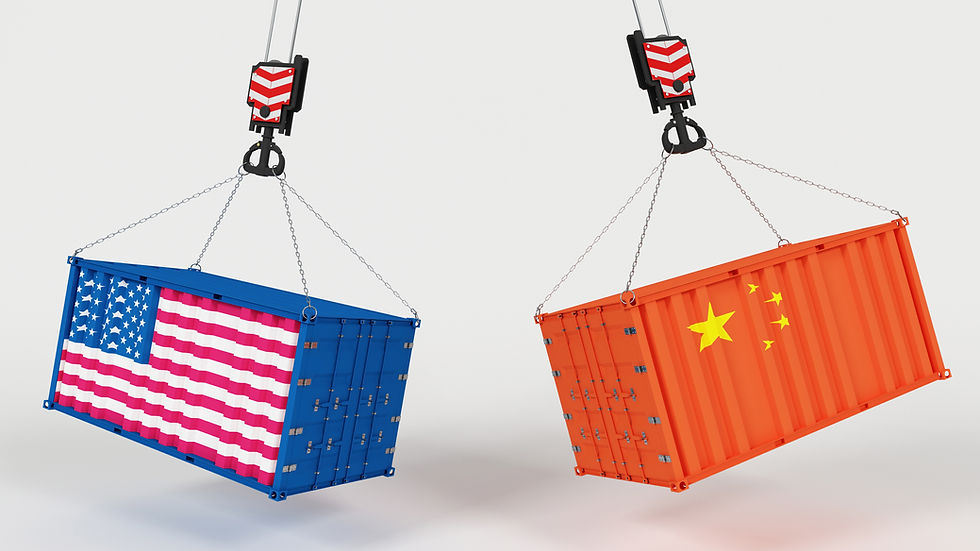U.S.-Japan Trade Negotiations: Navigating Currency Policies, Tariffs, and Economic Strategies
- admin cys
- May 1
- 3 min read
A Report by CYS Global Remit Counterparty Sales & Alliance Unit

The ongoing U.S.-Japan trade talks have become a focal point in global economic discussions, centring on currency exchange rates, tariffs, and trade barriers. These negotiations unfold against a backdrop of increasing tensions over trade imbalances and differing policy goals. Notably, U.S. Treasury Secretary Scott Bessent has highlighted the complexity of these discussions by emphasizing that there are "no currency targets" set for the current talks. This statement precedes a crucial meeting with Japanese Finance Minister Katsunobu Kato at the upcoming International Monetary Fund and World Bank gatherings in Washington.
This dialogue, distinct from bilateral tariff negotiations, holds significant weight due to its potential impact on both the global economic environment and the delicate balance of U.S.-Japan relations.
Currency and Trade Tensions: Dollar-Yen Dynamics
Currency manipulation accusations and trade imbalances have long posed challenges in U.S.-Japan relations. U.S. policymakers, particularly under President Trump, allege that Japan keeps the yen undervalued to benefit its export-oriented economy, which they claim worsens the U.S. trade deficit—a key concern for the administration.
In response, Trump has imposed a 24% tariff on Japanese exports, including a universal 10% rate and an additional 25% on cars. Although temporarily suspended, these tariffs have cast uncertainty over Japanese industries, especially the automotive sector—a pillar of Japan's economy.
The dollar-yen exchange rate is likely to feature prominently in upcoming discussions. Since January, the yen has appreciated approximately 9% against the dollar, driven by speculation that the U.S. may urge Japan to appreciate its currency. Such a shift could reduce the trade deficit by boosting the competitiveness of U.S. manufacturers. However, Japan maintains that exchange rates should be market-determined, advocating stability as essential for continued economic growth.
Bessent’s commitment to the G7 agreement—which prioritizes avoiding competitive devaluations and ensuring exchange rate stability—adds another layer of complexity to these discussions. Japan has expressed readiness for constructive engagement while adhering to its established currency policies.
Broader Economic Impact and Market Forecasts
The repercussions of these talks extend beyond bilateral relations. Market analysts, including those at Bank of America (BofA), have revised currency forecasts in anticipation of the negotiations’ outcomes. For instance, the USD/JPY exchange rate forecast has been adjusted downward, projecting a medium-term rate of 155 by the end of 2025. This reflects growing uncertainty around U.S. trade policies and their potential effects on global currency markets.
BofA analysts highlight risks to their forecasts, noting the possibility of a rapid depreciation of the U.S. dollar if trade negotiations falter. Conversely, easing trade tensions or implementing pro-growth policies could strengthen the dollar. They also emphasize that any risk premium tied to ongoing trade disputes might not fade soon. Other currency pairs, like EUR/USD and EUR/GBP, have been reassessed based on global economic trends. For example, increased fiscal spending in Germany or the EU could boost the euro, while rising energy prices and stalled EU reforms might present challenges. These factors underscore the interconnectedness of global economies, where developments in one region can have widespread effects.
For Japan, the stakes are particularly significant. With its economy heavily reliant on exports, any substantial changes in tariff structures or currency valuations could have far-reaching impacts. Japanese Finance Minister Kato has stayed measured in his comments, underscoring the need for market-determined currency rates and advocating for constructive dialogue.
Conclusion: Charting a Collaborative Path Forward
The U.S.-Japan trade negotiations illustrate the intricate relationship between currency policies, trade barriers, and economic strategies. Both countries have much at stake: reducing the trade deficit and bolstering domestic manufacturing are top priorities for the U.S., while Japan aims to protect its export-driven economy and ensure financial stability. The forthcoming meeting between Bessent and Kato is poised to delve into these complex issues. While Bessent has dismissed specific currency targets, discussions on tariffs and trade barriers are expected to shape the future direction of U.S.-Japan economic relations. The outcome of these talks could set the stage for future negotiations and potentially reshape the global economic landscape.
As the world observes, the focus will be on achieving a balanced approach that addresses the concerns of both nations while fostering stability and growth. Whether through tariff concessions, reaffirming market-driven currency policies, or working collaboratively to address non-tariff trade barriers, the path forward will demand diplomacy, pragmatism, and a mutual commitment to shared economic prosperity.
Source:
https://www.investing.com/news/forex-news/us-not-setting-currency-targets-in-trade-talks-with-japan-93CH-3999598 https://www.investing.com/news/forex-news/bofa-cuts-usdjpy-forecast-sees-end2025-target-at-155-93CH-4000922 https://www.investing.com/news/forex-news/japanese-and-us-finance-chiefs-to-discuss-yen-in-washington-talks-93CH-4003072









